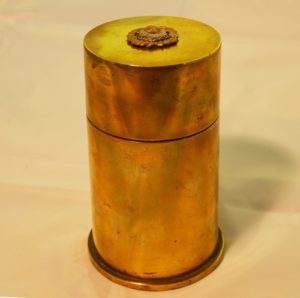*German, WW2, Early Sturmabteilung SA Army Honour Dagger, Scabbard & Hanger, Maker Marked Christianswerk, Solingen, Gau Marked NRH for Niederrhein District*
Approx measurements: 22cm blade, 34.8cm overall
Marked on the ricasso: Christianswerk, Solingen in an oval around a fork.
Marked on the obverse blade: “Alles für Deutschland”
Marked on crossguard: NRH
Marked on grip above crossguard: hand scratched R
This is an early, maker marked, SA Honour Dagger by Christianswerk, Solingen. Pre-1935 SA daggers were usually stamped with the SA group stamp (Gau) to the reverse of the lower cross guard. This cross guard has the Gau mark “NRH” signifying it was issued in the region of Niederhein. The grip has a R scratched into it – likely the owners initial.
This is very good example with nickel mounts, the blade etched “Alles für Deutschland” bearing the makers fork logo. The brown wooden grip inlaid with silvered eagle and swastika and enamelled SA logo. The pommel nut looks good. The cross guard is engraved Nrh for the Niederrhein District. The dagger is housed in the correct brown anodised scabbard with nickel mounts, the top mount with a single suspension ring and it is complete with its’ hanger – unmarked as is correct pre 1935.
The daggers produced by Christianswerk, Solingen are particularly collectible due to their craftsmanship and association with the early, formative years of Nazi military history.
Background:
The Sturmabteilung (SA), or “Brown Shirts,” formed in 1921 as the Nazi Party’s original paramilitary force. Co-founded by Adolf Hitler and Ernst Röhm, the SA was initially composed of WWI veterans and members of the Freikorps, a post-war paramilitary group. The SA’s main purpose was to provide security at Nazi rallies, intimidate political opponents, and carry out street-level violence to promote Nazi ideology. The SA played a pivotal role in the Nazi rise to power during the 1920s and early 1930s, with its aggressive tactics and strong-arm approach giving the party a militant presence.
However, the SA’s growing power and influence, especially under Röhm’s leadership, became a threat to Hitler’s control. In 1934, during the “Night of the Long Knives,” Röhm and many SA leaders were purged by the SS under Hitler’s orders, significantly weakening the organization and reducing its role to a ceremonial body. Like many Nazi branches, the SA adopted paramilitary uniforms and insignia, including the distinctive SA dagger.
The SA Dagger:
The SA dagger was introduced in 1933 as a standard service dagger for its members and symbolized loyalty and service to the SA and Nazi ideology. It was designed by Professor Woenne and modeled after a traditional German dagger displayed in the Munich City Museum. The dagger bore the inscription “Alles für Deutschland” (“All for Germany”) on its blade, and its early models featured high-quality materials such as hand-fitted nickel fittings, hardwood grips, and brown anodized scabbards. Produced by 123 different manufacturers, the dagger went through variations as production increased, including the shift to less expensive plated zinc-based fittings and painted scabbards.
Initially, pre-1935 SA daggers were stamped with an SA group code on the reverse of the lower crossguard to indicate the distribution group. However, after 1935, the introduction of the Reichszeugmeisterei (RZM) codes mostly replaced these markings as the central licensing authority for all Nazi-related items. On May 19, 1936, NSKK-Korpsführer Adolf Hühnlein ordered all NSKK dagger scabbards to be black painted or factory-anodized to differentiate from the SA.
Christianswerk:
Founded in 1824 by Karl Wilhelm and Johann Abraham Christians, Gebrüder Christians, Christianswerk Stahlwarenfabrik began as a boot manufacturer before expanding into blades, knives, and tools by 1910. The company, based in Solingen, registered its trademark in 1875 and grew under successive generations.
By the 1930s, Christianswerk specialized in edged weapons, receiving its RZM M7/1 license in 1935. It became a key producer of daggers for the NSDAP, particularly SA daggers, with most products dated 1938. The company relocated multiple times, including to Adolf-Hitler-Platz in 1939. Post-war, Christianswerk continued operations and remained a global supplier, run by three generations of brothers until 1975. It is still in business today.
*Condition*
The dagger is in great overall condition. There are some scuff marks and scratches to the grip. The early solid nickel eagle is wonderfully detailed and sits perfectly in the grip. The double edged blade is sharp. The scabbard fits firmly and there are scuff marks to the scabbard and the finial is slightly squashed to the right. Please see photographs as part of the condition report.
JAQ#SQ2443#EOO_5783195648




































































